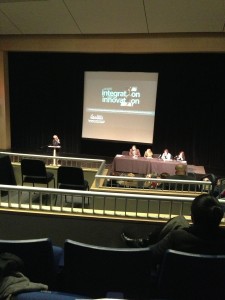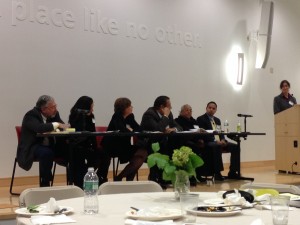Last weekend, educators, policy creators, and history makers gathered for the, “Where Integration Meets Innovation” conference, organized by One Nation Indivisible, and in collaboration with the Sheff Movement Coalition. The conference was a two-day event, hoping to bring public attention to, “creating, sustaining and improving dynamic and diverse public schools for the 21st century. [1]” Friday afternoon’s events included a luncheon and panel discussion, utilizing space at the Hartford Public Library, and Saturday morning’s events incorporated a diverse number of speeches at the Greater Hartford Academy of the Arts. Both of these events shed light on the paradigm of school reform, specifically in relation to the Sheff movement and its goals. Friday’s panel included Attorneys for the Plaintiff’s in Sheff v. O’Neill, such as Martha Stone, Dennis Parker and Alex Knopp, Columbia University Professor Amy Stuart Wells, and Senior Policy Fellow at Connecticut Voices For Children and Hartford Board of Education member Robert Cotto. Elizabeth Horton Sheff, lead plaintiff for the Sheff movement withstanding 24 years, addressed both Friday and Saturday’s attendees, calling attention to the irony within the “hollow victories” in which the government stakes it’s claims for acute and active school reform. For example, the ideology of an idealized “Sheff school choice” versus the currently implemented “school choice” within Hartford and its surrounding suburbs was debated. “Magnet schools with high achievement rates, do not mean integrated,” noted Knopp, a Yale Law School graduate. Open choice is a program that offers suburban kids the opportunity to attend urban schools, and vice versa; it is a process which is intended to create more integrated schools and bridge achievement gaps between white and minority students. However, Knopp pointed to the differences between schools under school choice which have higher achievement levels, and schools under the choice program that have higher achievement levels and an integrated learning environment. The topic provoked further questions offered up by Knopp, such as, “to what extent should open choice be mandated for suburb schools to give seats to urban schools?” These topics spiraled into questions of locational poverty amongst the city, racial steering and redlining practices, as well as projections on how to connect integrated schools with integrated housing, all of which the panel members addressed from their point of expertise.
In contrast with Friday’s panel discussion, the opening remarks on Saturday morning were not intended to educate the public on Sheff goals or how the current education system is failing its students. Saturday’s goal was to ignite a spark within the conferences attendees, a spark that had the potential to create actual change within the system. “We are spending too much time talking, and not enough time taking action,” preached Bruce Douglas, the Executive Director of the Capital Region Education Council. He continued, “There is more poverty and family dysfunction within schools now than ever,” and concluded that, “Education is in a state of emergency, and it must be addressed with a sense of urgency.” But the goal of his sermon, as others that Saturday morning, were not to convince people to get up out of their seats and take action. Most of the people at the conference were those who had already taken action, and were already “heroes” in the fight for a better education system. “That’s the problem with these conferences,” Douglas professed. “I am not talking to try and convert you….I am already talking to the converted.” The tone of Saturday’s conference was less informative about the issues, but moreover the beginnings of an instruction manual, on how to bring the information to the public and encourage others to take action. Because talking the talk is one thing, but walking the walk takes guts.


[1] Where Integration Meets Innovation, Conference Agenda Packet





